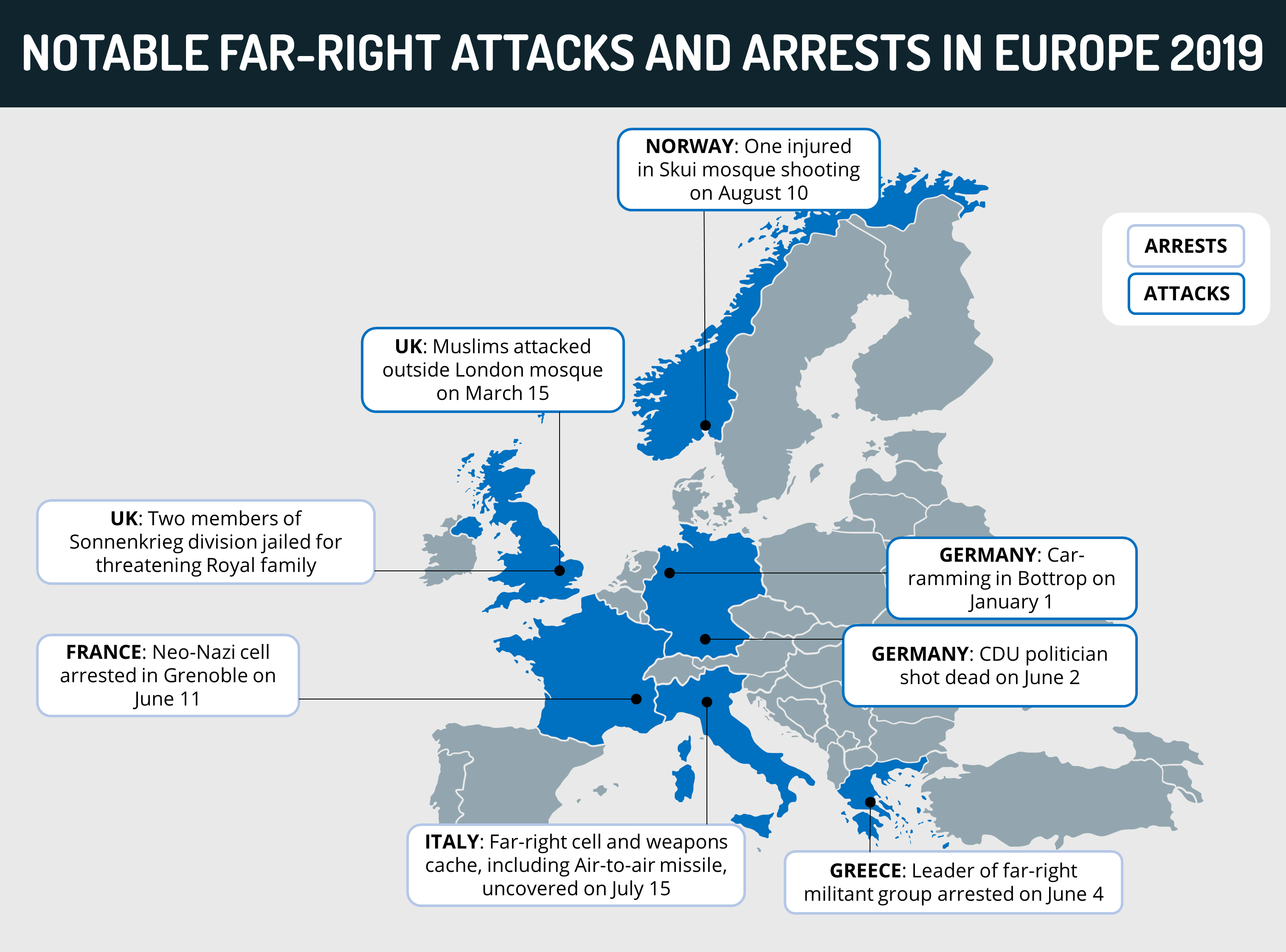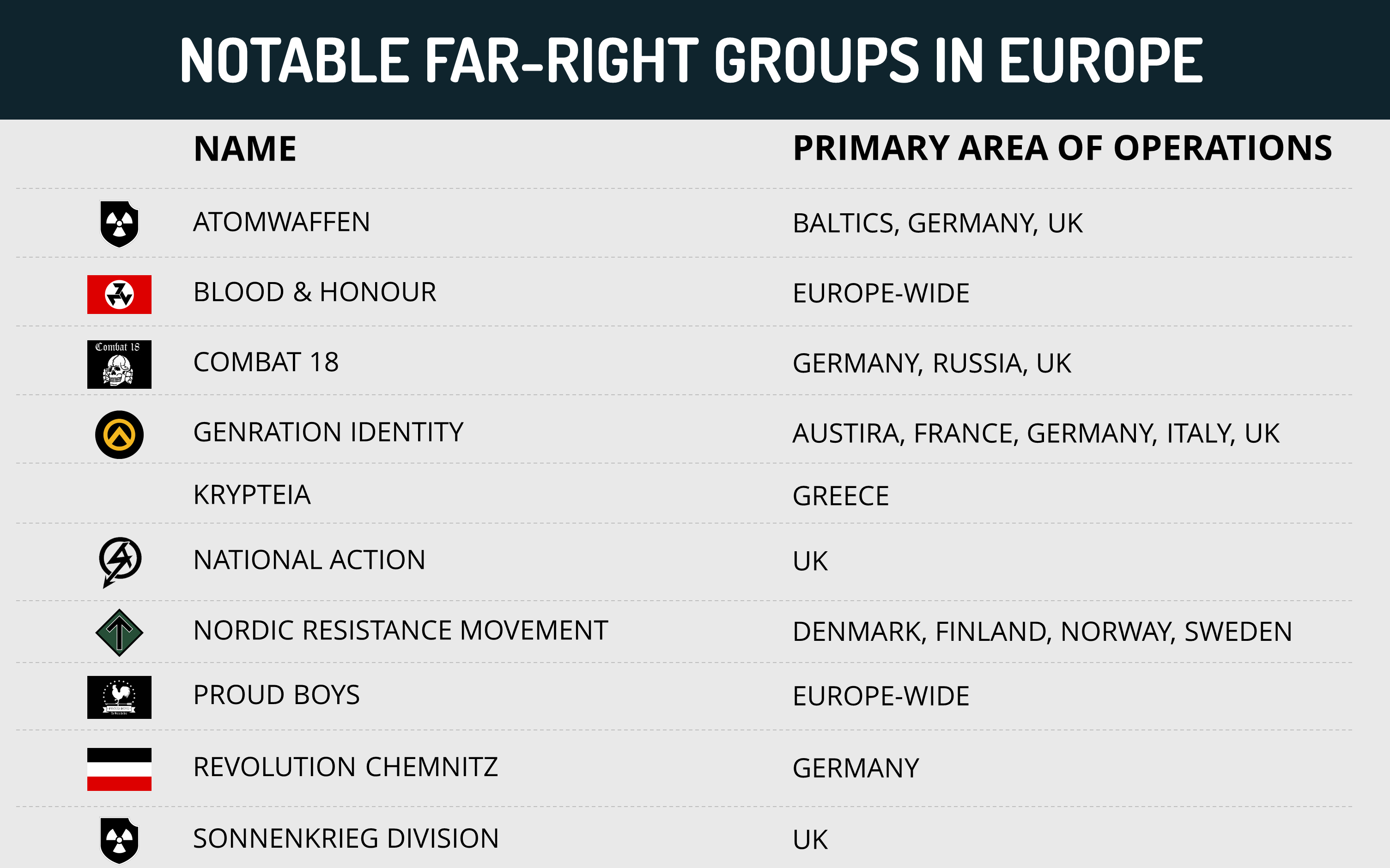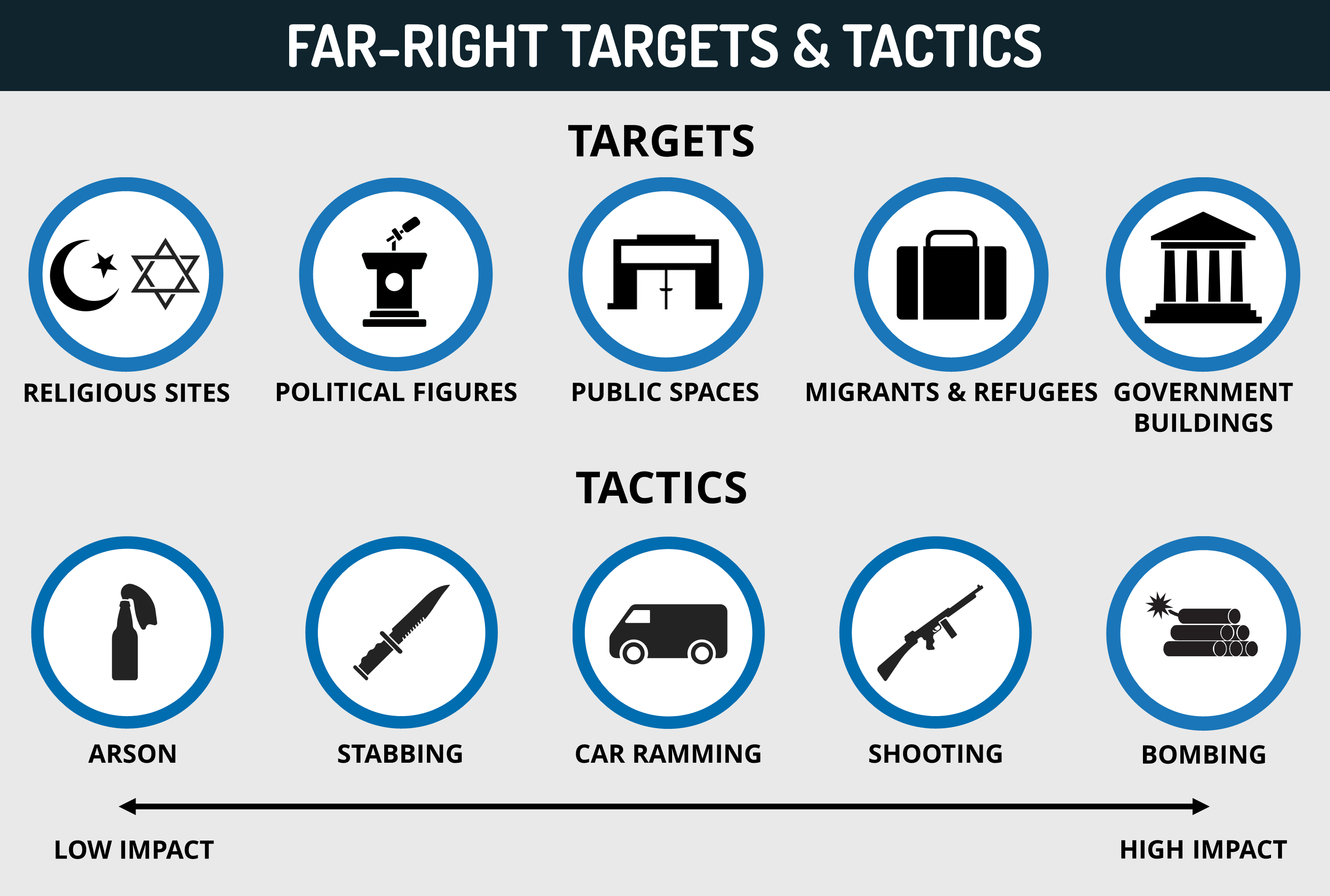Executive Summary
A series of attacks and arrests linked to far-right individuals in Europe, as well as statistics and official statements from a number of European governments, underscore the threat as fast becoming the primary militant issue going forward.
Modern right-wing militancy has taken on a particularly transnational character, with online forums enabling communication and radicalization between countries.
Attacks in one country can easily spur similar copy-cat incidents in others due to social media and international news coverage.
Far-right militants come in two forms. Major cells will continue to form and operate but are more likely to be detected by security forces. Lone-wolves constitute the most significant threat but, in most cases, do not have the access to fire-arms of their American counterparts.
Far-right attacks are likely to grow in number across Western and Northern Europe, with migrant, religious, and political targets being specifically singled out.
Recommendations
Security plans should be updated to reflect the relevant threats associated with far-right militancy, including up-to-date training for staff, particularly regarding both the online and in-person profiles of attackers. Pay attention to differing threats from organized cells and lone-wolf individuals.
Public, private, and third sector organizations are advised to increase their awareness of threats on social media through the use of threat monitoring services. Increased awareness of an organization’s political footprint and perceptions from fringe online groups can help uncover potential violent actors and plots before they occur.
Institutions should increase their intelligence collection capabilities, including HUMINT, OSINT, and Deep & Dark web searches in order to understand the full spectrum of threats.
Immediately alert authorities of any suspicious behavior or items.
Background
The rise of far-right ideologies in Europe saw a milestone during the European Parliament elections in 2019 when a number of far-right, alt-right, or populist parties were some of the top-performing political groups. In France, Italy, and the UK, far-right or populist-right parties came top, with similar outcomes reported in a number of other countries, and populist right parties increasing their total share of the European Parliament by almost 30%.
On August 14, the German Interior Ministry released figures registering 8,605 “right-wing extremist” offenses in the first half of 2019. This was an increase by over 900 compared to the same period of 2018. The 8,605 crimes attributed to far-right groups or motives included 363 violent incidents, with at least 179 people injured. Some sources indicated that the actual number of incidents could be higher due to state police officials often classifying right-wing offenses as non-political in initial reports.
In addition, a number of major political and social developments occurred in Europe which increased and catalyzed far-right sentiments across the continent. These included the migrant and refugee crisis, perceptions of economic disparity, the increase in militant incidents attributed to the Islamic State, the growth of social media as the primary method of consuming media, and a rise in Euroscepticism, illustrated through Brexit. Broadly, this built on a disillusionment with the centrist and center-left politics which dominated large parts of the West for much of the last decade.
Concurrently, crimes attributed to anti-Semitic, Islamophobic, racist, xenophobic sentiments saw significant increases in a number of European countries in the previous decade. In Germany, the number of criminal incidents per year that were attributed to such sentiments increased by around 47% from 2007 to 2018. Similarly, in the UK, there was an increase of around 45% between 2011 and 2016, with the numbers further rising after Brexit.
A number of European governments have spoken out in recent months of the significantly increasing threat of far-right groups in the region. In July, the UK’s Home Office warned that right-wing extremists were forming the most significant group of militants in the country, while the far-right threat was included in the official terrorist warnings for the first time. In Germany, Interior Minister Horst Seehofer claimed that the June 2 shooting of a CDU politician should serve as a “wake-up call” for the country, arguing that “right-wing extremism is a serious danger for our free society.”
Assessments and Forecast
Transnationalization of the far-right through online forums
One development in the current state of the far-right is the transnational character it has taken on, largely through communications online and shared grievances among a number of Western countries. The transnational nature of a globally interconnected world, which has become a focus of many far-right talking points, meant that individuals who would be susceptible to far-right ideologies began feeling affected by similar issues throughout the world. It is through these shared issues that global echo chambers arose of far-right sympathizers who congregate online to discuss problems of immigration, conspiracies of Jewish power, white supremacy, and other extremist ideas.
Much of this transnational communication came through access to social media and online forums which either cater to such ideas or are unable to police the content. The rise of ‘meme culture’ bolstered this ideology, as users were able to radicalize new members by presenting extremist political ideas through cartoons and jokes, bypassing the negative connotations of neo-Nazism or fascism. Many of the more extreme members of the far-right online community have migrated to websites such as Gab and 8chan, which have little to no restrictions on content and, therefore, become hotbeds for far-right and neo-Nazi activity.
The global nature of news media has also increased the transnational nature of the far-right. As the ideology focuses on the preservation of the ‘white race,’ any incident in the world which is carried out in the name of this goal is highly praised by such communities, regardless of where the attack took place. In this regard, it is notable that two far-right attacks were recorded in the UK and one in Norway following the widespread sharing of news about the Christchurch attacks. Mass attacks in one country are highly likely to spur copycat attacks abroad in the following weeks, particularly in countries with similar cultural and linguistic backgrounds.
With regards to government action to stop far-right militancy, the transnational and loosely structured nature of online far-right activism means that, while security forces may be able to foil attacks, a government attempt to fight the ideology will be difficult. It is highly unlikely that any single government will be able to successfully undertake a deradicalization program without the help of the international community. With that, it is likely that this phenomenon will continue to expand in Europe, with various right-wing governments reluctant to fully engage in fighting the far-right, due to political benefits of discussing grievances such as immigration.
Organized Militant Cells
Organized militant groups represent the long-term progression of neo-Nazi cells, which have galvanized in popularity following a general increase in far-right sentiments and through far-right culture online. These cells often form doctrines based around neo-Fascist ideologies, historical revisionism, and frequently link to other subcultures such as local gangs, hooliganism, and fringe political parties. For the most part, many of these groups continue to look up to some form of National Socialism or local brand of extremist nationalism. Many have built strong online followings and grow their support through encrypted messaging apps, online forums, and social media.
These groups make up a large number of the far-right-linked arrests in Europe. Security forces often track members who have been involved in weapons smuggling. Furthermore, such groups are likely to have links with certain members of the military or far-right political parties in their respective country. This has largely played a role in helping groups with training, planning, and building networks. The groups, similar to many other extremist militant organizations, are often more popular among disenfranchised members of society, particularly focussing on young white males who feel abandoned by the political direction of their country, and Europe in particular.
It is important to note that much of the structure of modern far-right groups, including the online base, use of encrypted social media, knowledge of attack methods, and even choice of methods come from behavior learned from Islamist cells in Europe. Many of these groups strongly followed news about jihadism in Europe and likely used this template to help construct their own groups.
Far-right cells are more likely to attempt to carry out major attacks than lone-wolves, with goals of fundamentally changing or affecting the political system of Europe. Many foiled incidents have seen groups building large arms caches, looking to target high profile political or religious targets, meanwhile much of their rhetoric continues to have revolutionary themes. Future attack plans, whether successful or not, are likely to include attempts to build powerful IEDs or carry out multi-faceted and sophisticated attacks, involving a number of methods and targets. Far-right militant groups are likely to look to target individuals or institutions which they believe represent a specific threat to their ideology, including refugee centers, mosques and synagogues, minority leaders, and left-wing political figures or events.
Lone-Wolf Militants
As with the trend in other types of militancy, far-right militancy in Europe has also moved towards a lone-wolf angle. This likely comes from two main sources. First, lone-wolf attacks are much easier to carry out, as they avoid the high-risk communications between various different cell-members, which are more likely to alert security forces. Similarly, planning can be done alone and in secret. Second, the extremely visible trend of lone-wolf shootings with a far-right character in the USA, catalyzed, in part, by a dramatic increase in extremist and violent rhetoric online, has led to the radicalization of young, often mentally unstable men.
While lone-wolf attacks in Europe are unlikely to be as destructive as they are in the USA, largely due to the difficulty in obtaining firearms, they remain the most likely types of attacks. Unlike the attacks by larger militant cells, such attacks are likely to be unsophisticated and have lower impact. Many of the attacks may involve vehicular rammings, stabbings, or shootings with low-quality firearms.
Lone-wolf attacks are likely to be similarly targeted, looking to focus on individuals, institutions, or events which are particularly relevant to the far-right ideology, however, they are also likely to be far smaller and more local in character. It’s more probable that a lone-wolf will attack within their town or the area of their city, rather than traveling to the capital, in an attempt to carry out a major attack. This will likely increase the number of attacks happening in more peripheral areas in Europe.
Notable Militant Incidents
Attacks in 2019
Germany: A Christian Democratic Union (CDU) politician was shot dead on June 2, 2019, described by authorities as an ‘execution’ by a person who justified it based on the politician’s ‘pro-refugee’ stance. While details of the shooter were sparse in the days following the incident, far-right forums immediately began celebrating the shooter, attributing it as revenge for the politician’s support for migration. On June 15, a 45-year-old man was arrested in connection with the incident, with police confirming their suspicions of a far-right motive.
Germany: On January 1, 2019, an individual rammed his car into a crowd in Bottrop, western Germany in an attack suspected to be motivated by far-right ideologies. Among the people injured, seven were migrants, including two children. When the suspect was detained in Essen, after attempting to ram another set of pedestrians, he reportedly made racist remarks to police officers, with a member of the Christian Democratic Union (CDU) party calling it an act of ‘right-wing violence’.
Norway: On August 10, one person was injured when an individual wearing a uniform and body armor entered a Mosque in Skui, just outside of Oslo, and shot at three congregants. The man entered with two shotguns and a pistol and was later arrested by police. He is believed to have been influenced by far-right ideologies.
UK: On March 15, 2019, Muslim individuals were attacked with hammers outside of east London mosque by three men who were said to have shouted Islamophobic abuse. The attack occurred a number of hours after the Christchurch attack in New Zealand, in which 51 Muslim worshipers were killed in two mosques.
Arrests in 2019
France: On June 11, French authorities arrested members of a neo-Nazi cell across the country, beginning in Grenoble with the arrest of a volunteer police officer who had been amassing weapons. The members had been planning to attack Jewish institutions and Muslim places of worship. Five members of the group were closely associated with neo-Nazi ideologies and were charged between September 2018 and May 2019. Among the targets was the annual dinner of the Representative Council of French Jewish Institutions (CRIF). Naming themselves ‘L’Oiseau Noir’ (Black Bird), they were charged under terror offenses and for being part of a militant conspiracy.
Greece: Greek police arrested a man they believed to be the leader of the far-right militant group ‘Krypteia’ on June 4. The detained individual worked as a professor and is expected to be charged with arson, possession of weapons, and threats. The group has previously been implicated in an arson attack on an Afghan community center in March 2018, for ‘firebombing’ a migrant center in Athens in April 2018, and setting fire to a migrant camp Nea Manolada, Ilia in June 2018. Separately, the group claimed to have carried out over 21 attacks in 2018 in a leaked email.
Italy: Multiple military weapons, including a functioning air-to-air missile, were seized from a far-right group in Turin, northern Italy, per July 15 reports. Additional raids took place in Forli, Milan, Novara, Pavia, and Varese in conjunction with Direzione Centrale della Polizia di Prevenzione (DCPP). It reportedly was conducted following an investigation into individuals with extremist ideologies who took part in the conflict in eastern Ukraine. Three people were arrested including a former candidate for Senate for the far-right Forza Nuova. In addition to the weapons, authorities found large amounts of pro-fascist or Nazi memorabilia.
UK: Two teenage members of far-right groups from Leeds and west London were jailed on June 18 for calling for attacks on Prince Harry over his marriage to Duchess of Sussex Meghan Markle and minorities including non-white and Jewish people. The men, 18 and 19 years old, were part of the Sonnenkrieg Division, a far-right neo-Nazi group. An online blog run by one of the men included violent misogynistic content, including multiple calls for violent sexual assault, calling for readers to become ‘a machine of terror’. He was also found in possession of bomb-making instructions inspired by similar material used by militant Islamist groups. Both individuals were active online on the website Gab, which predominantly features a right-wing user base, designing propaganda to encourage militant attacks and to recruit members.



